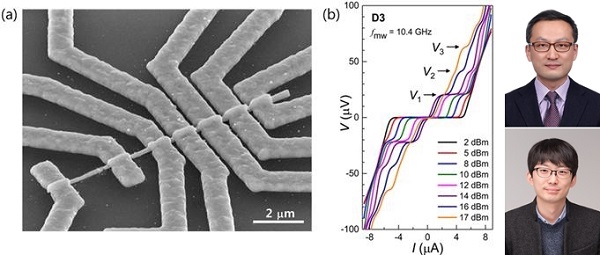Media Center
A multimedia mosaic of moments at GIST
GIST Excellence
[Press Release] Professor Youg-Joo Doh"s research team develops a super-current transistor with higher maximum operating temperature
- 엘리스 리
- REG_DATE : 2017.01.23
- HIT : 1084
Professor Yong-Joo Doh"s research team develops
a super-current transistor with higher maximum operating temperature

□ Professor Yong-Joo Doh of the Gwangju Institute of Science and Technology (GIST) Department of Physics and Photon Sciene) has succeeded in developing a "super-current transistor" that improves the operating temperature and maximum critical current by using a semiconductor nanowire *.
∘ This is expected to greatly contribute to the research and development of a quantum computer device by using a super-current transistor to greatly improve the operating performance when compared to conventional super-current transistors.
* Semiconductor nanowires: nanorods that are made of semiconductor materials or one-dimensional nanostructures in the form of nanowires
* Secondary current: The current flowing in a superconducting material state where the resistance becomes zero while two electrons are paired to form a "Cooper pair." The power loss due to the current does not occur even when the current flows. The super-current transistor is a transistor device that applies the principle of quantum physics to turn on and off the super-current by applying a voltage to the gate electrode, and it can be used as a qubit that is a quantum computer unit element.
□ Superconducting materials have the advantage of keeping the resistance to 0 and allowing the current to flow without heat loss. However, to make full use of the superconducting material, it is necessary to freely control the on or off of the superconducting current.
The "super-current transistor," which is being studied for this purpose, can control the flow of super-current by artificially controlling the number of transport charges inside the semiconductor nanowire. Due to the barrier between the superconductor electrode and the semiconductor material, the magnitude of the flowing current is very small.
∘ This small current of small size is vulnerable to the thermal noise generated by the temperature, which makes the superconducting transistor difficult to apply because it is forced to operate at a cryogenic temperature of 1 Kelvin (1K = minus 272 ℃).
* Absolute temperature: The temperature system expressed in Kelvin. Absolute zero (0 Kelvin) corresponds to minus 273.15 ℃.
Professor Yong-Joo Doh"s research team formed a high-quality junction by attaching a superconducting electrode made of lead and an indium alloy to a semiconductor lead wire of sulfide lead to improve the critical current value of the super current by more than 100 times and, from this, developed the superconducting current transistor.
In the case of a conventional super-current transistor, the supercurrent transistor has a maximum critical current value of about 0.1 μA * and the operating temperature is less than 1 Kelvin. The super-current transistor developed by the research team has a threshold current value of 10 μA or more, which is equivalent to the temperature of liquid helium at about-268 ° C.
* Microamperes (μA): One microamp is one millionth of an amperage.
"This result is significant because it has improved the operating temperature of conventional ultra-current quantum devices operating at cryogenic temperatures up to liquid helium temperatures (4.2 Kelvins)," Professor Doh Yong-joo said. "In addition to its operating temperature, "We plan to develop a super-current transistor using a phase insulator * to sustain the state."
* Phase insulator: A new material that has an energy gap similar to a general insulator, but has a metallic electrical conductivity on the surface of the insulator along topological conditions. The quantum state generated in the phase insulator super-current transistor is more stable than conventional semiconductors. It is expected that this research will play a crucial role in future quantum computer implementation of quartz current and research on detection of unusual artificial quasiparticles, such as maroon fermion.
This study, led by Professor Yong-Joo Doh (correspondent author) and Dr. Bum-kyu Kim (first author and postdoctoral researcher), was supported by the Ministry of Science, ICT and Future Planning"s Center for Core Research and Leading Research Center (SRC) and was published online in ACS Nano, on January 4, 2017.